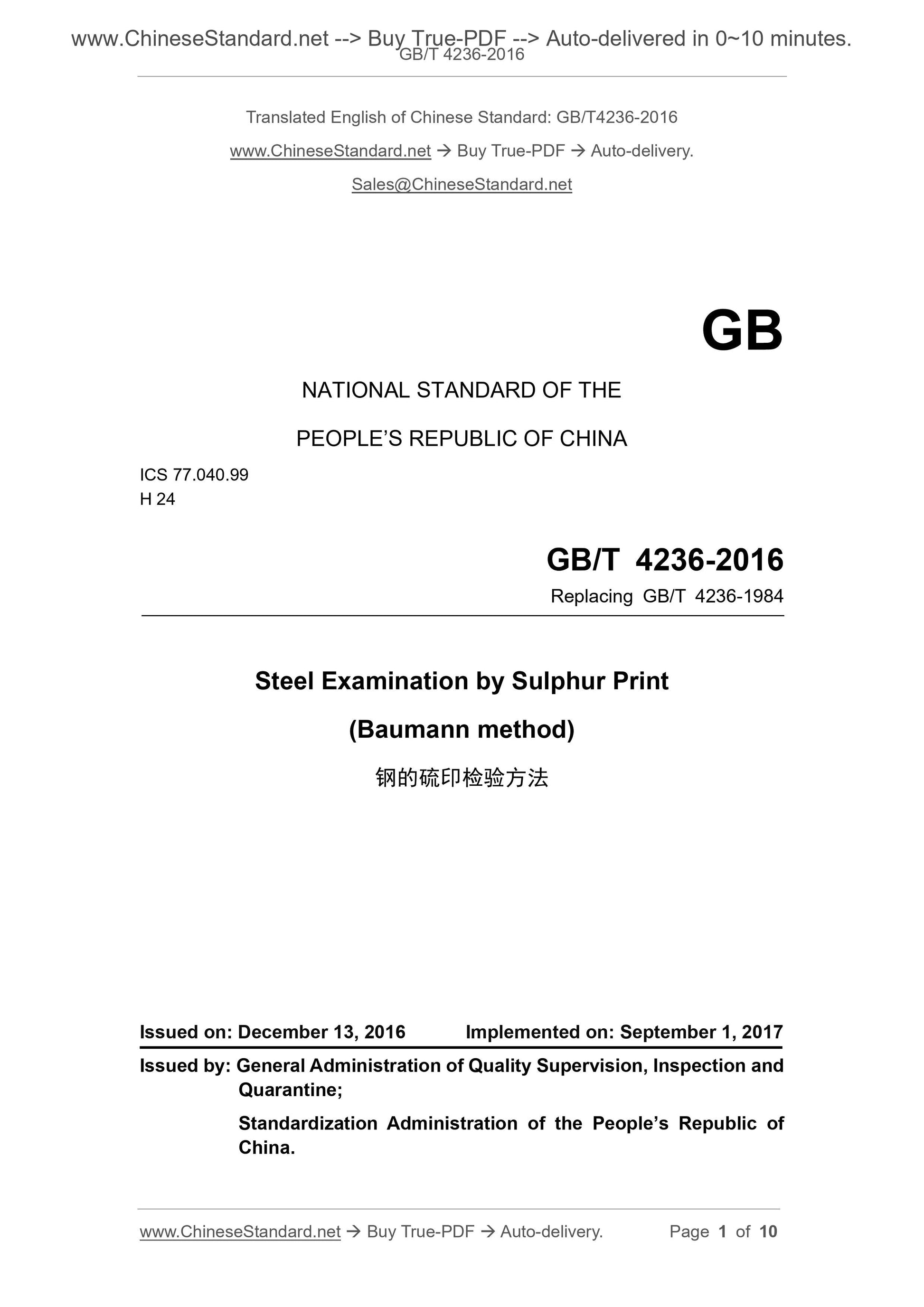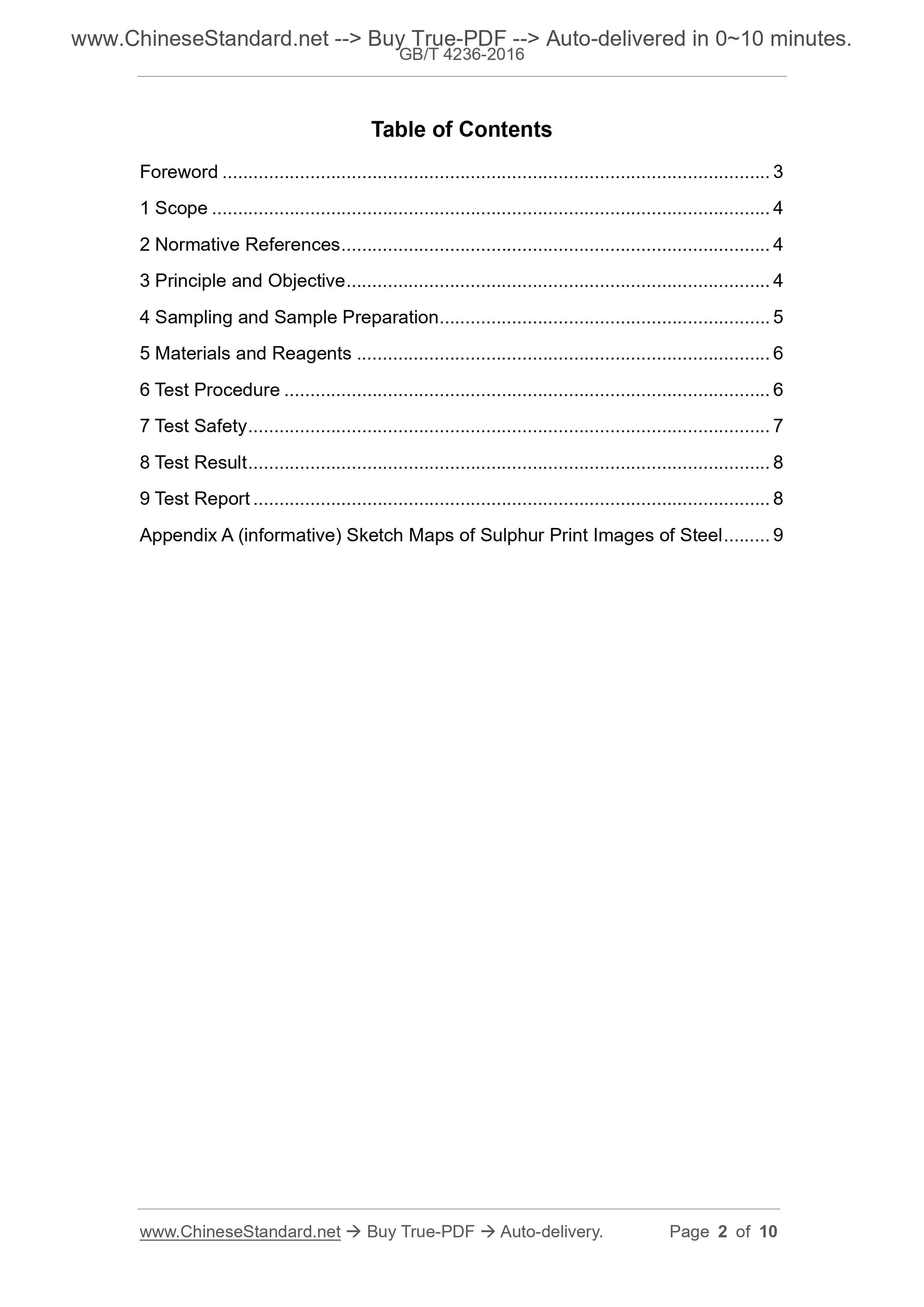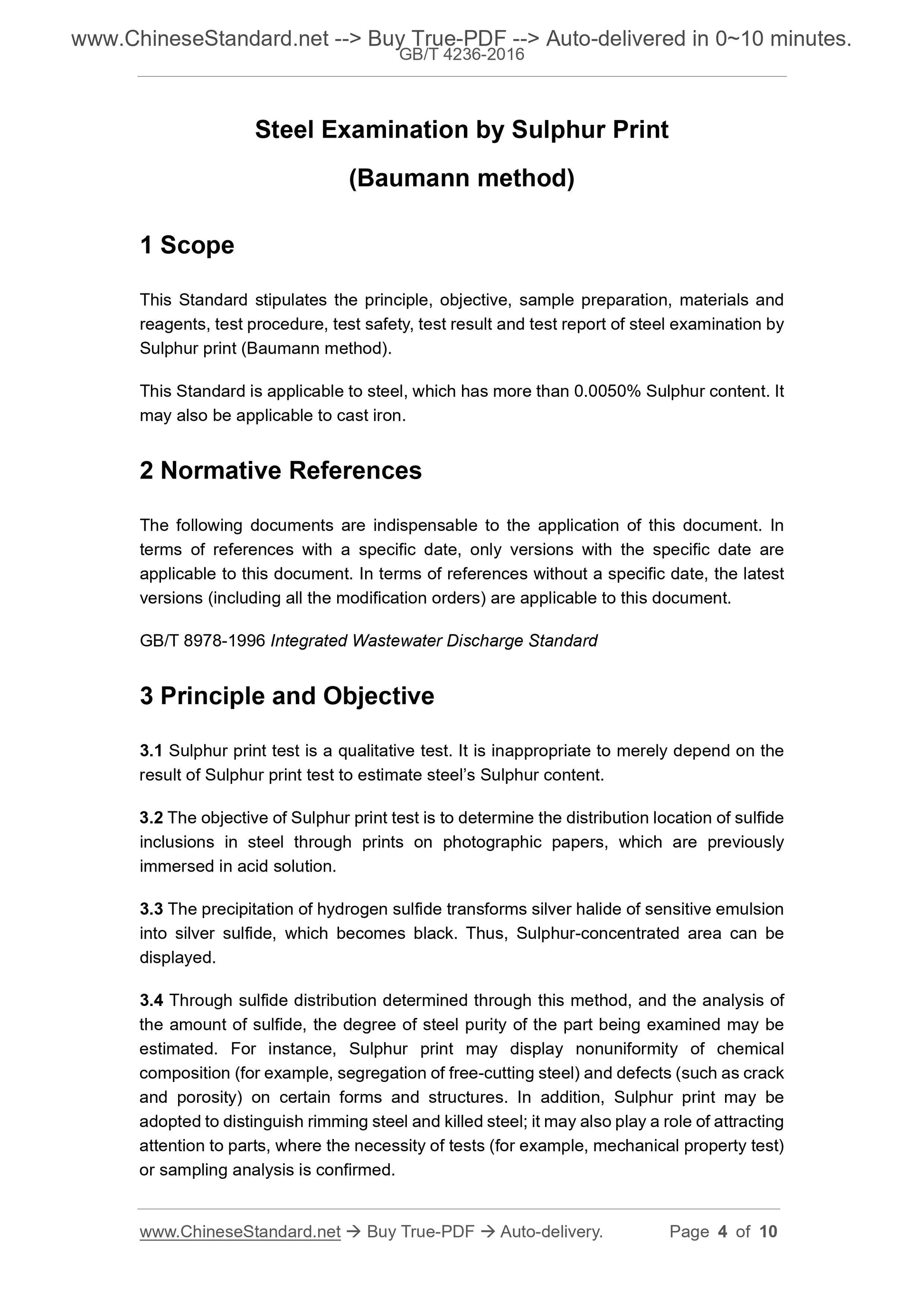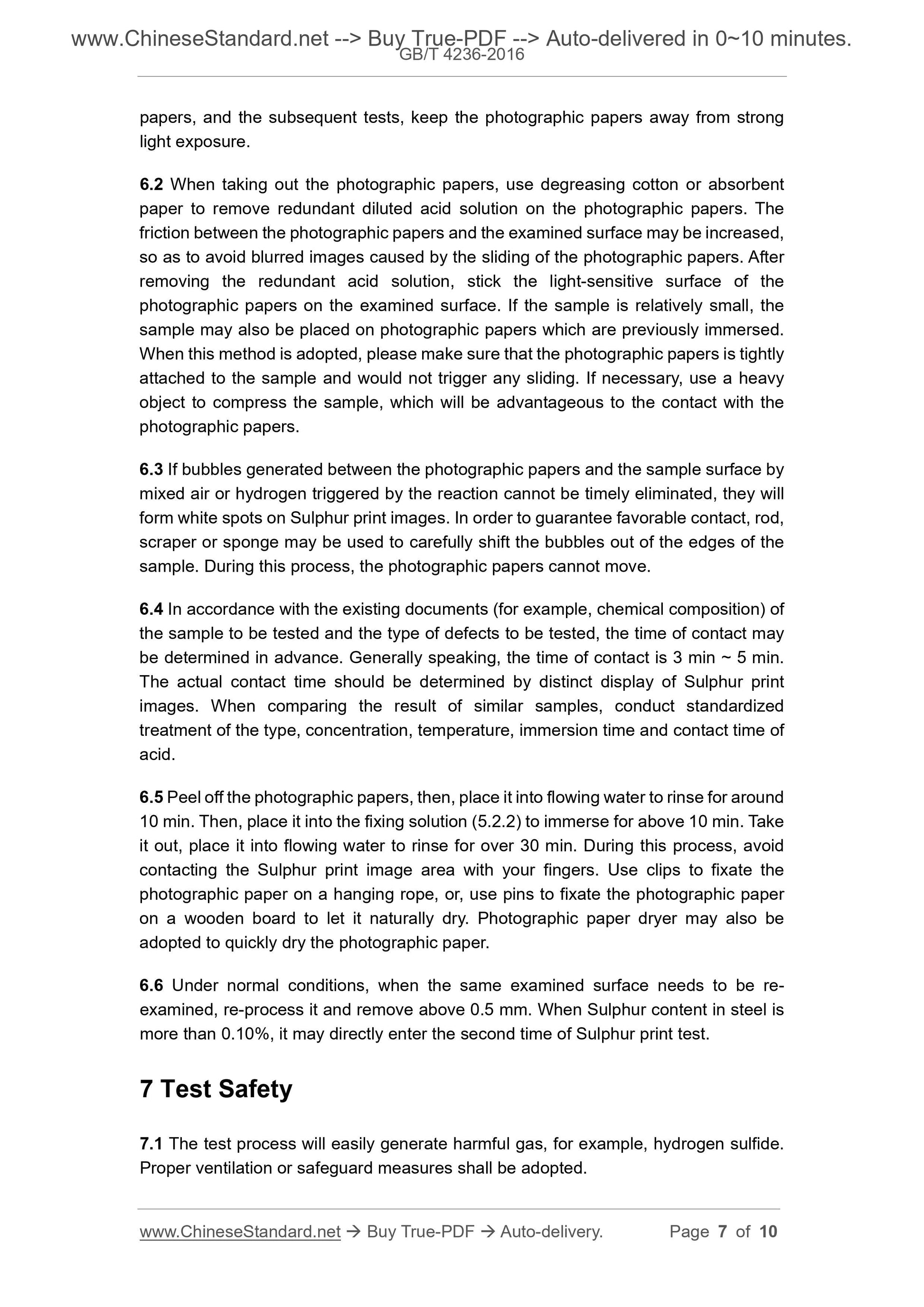1
/
of
4
PayPal, credit cards. Download editable-PDF and invoice in 1 second!
GB/T 4236-2016 English PDF (GBT4236-2016)
GB/T 4236-2016 English PDF (GBT4236-2016)
Regular price
$150.00 USD
Regular price
Sale price
$150.00 USD
Unit price
/
per
Shipping calculated at checkout.
Couldn't load pickup availability
Delivery: 3 seconds. Download true-PDF + Invoice.
Get QUOTATION in 1-minute: Click GB/T 4236-2016
Historical versions: GB/T 4236-2016
Preview True-PDF (Reload/Scroll if blank)
GB/T 4236-2016: Steel examination by sulphur print (Baumann method)
GB/T 4236-2016
NATIONAL STANDARD OF THE
PEOPLE’S REPUBLIC OF CHINA
ICS 77.040.99
H 24
Replacing GB/T 4236-1984
Steel Examination by Sulphur Print
(Baumann method)
ISSUED ON: DECEMBER 13, 2016
IMPLEMENTED ON: SEPTEMBER 1, 2017
Issued by: General Administration of Quality Supervision, Inspection and
Quarantine;
Standardization Administration of the People’s Republic of
China.
Table of Contents
Foreword ... 3
1 Scope ... 4
2 Normative References ... 4
3 Principle and Objective ... 4
4 Sampling and Sample Preparation ... 5
5 Materials and Reagents ... 6
6 Test Procedure ... 6
7 Test Safety ... 7
8 Test Result ... 8
9 Test Report ... 8
Appendix A (informative) Sketch Maps of Sulphur Print Images of Steel ... 9
Steel Examination by Sulphur Print
(Baumann method)
1 Scope
This Standard stipulates the principle, objective, sample preparation, materials and
reagents, test procedure, test safety, test result and test report of steel examination by
Sulphur print (Baumann method).
This Standard is applicable to steel, which has more than 0.0050% Sulphur content. It
may also be applicable to cast iron.
2 Normative References
The following documents are indispensable to the application of this document. In
terms of references with a specific date, only versions with the specific date are
applicable to this document. In terms of references without a specific date, the latest
versions (including all the modification orders) are applicable to this document.
GB/T 8978-1996 Integrated Wastewater Discharge Standard
3 Principle and Objective
3.1 Sulphur print test is a qualitative test. It is inappropriate to merely depend on the
result of Sulphur print test to estimate steel’s Sulphur content.
3.2 The objective of Sulphur print test is to determine the distribution location of sulfide
inclusions in steel through prints on photographic papers, which are previously
immersed in acid solution.
3.3 The precipitation of hydrogen sulfide transforms silver halide of sensitive emulsion
into silver sulfide, which becomes black. Thus, Sulphur-concentrated area can be
displayed.
3.4 Through sulfide distribution determined through this method, and the analysis of
the amount of sulfide, the degree of steel purity of the part being examined may be
estimated. For instance, Sulphur print may display nonuniformity of chemical
composition (for example, segregation of free-cutting steel) and defects (such as crack
and porosity) on certain forms and structures. In addition, Sulphur print may be
adopted to distinguish rimming steel and killed steel; it may also play a role of attracting
attention to parts, where the necessity of tests (for example, mechanical property test)
or sampling analysis is confirmed.
papers, and the subsequent tests, keep the photographic papers away from strong
light exposure.
6.2 When taking out the photographic papers, use degreasing cotton or absorbent
paper to remove redundant diluted acid solution on the photographic papers. The
friction between the photographic papers and the examined surface may be increased,
so as to avoid blurred images caused by the sliding of the photographic papers. After
removing the redundant acid solution, stick the light-sensitive surface of the
photographic papers on the examined surface. If the sample is relatively small, the
sample may also be placed on photographic papers which are previously immersed.
When this method is adopted, please make sure that the photographic papers is tightly
attached to the sample and would not trigger any sliding. If necessary, use a heavy
object to compress the sample, which will be advantageous to the contact with the
photographic papers.
6.3 If bubbles generated between the photographic papers and the sample surface by
mixed air or hydrogen triggered by the reaction cannot be timely eliminated, they will
form white spots on Sulphur print images. In order to guarantee favorable contact, rod,
scraper or sponge may be used to carefully shift the bubbles out of the edges of the
sample. During this process, the photographic papers cannot move.
6.4 In accordance with the existing documents (for example, chemical composition) of
the sample to be tested and the type of defects to be tested, the time of contact may
be determined in advance. Generally speaking, the time of contact is 3 min ~ 5 min.
The actual contact time should be determined by distinct display of Sulphur print
images. When comparing the result of similar samples, conduct standardized
treatment of the type, concentration, temperature, immersion time and contact time of
acid.
6.5 Peel off the photographic papers, then, place it into flowing water to rinse for around
10 min. Then, place it into the fixing solution (5.2.2) to immerse for above 10 min. Take
it out, place it into flowing water to rinse for over 30 min. During this process, avoid
contacting the Sulphur print image area with your fingers. Use clips to fixate the
photographic paper on a hanging rope, or, use pins to fixate the photographic paper
on a wooden board to let it naturally dry. Photographic paper dryer may also be
adopted to quickly dry the photographic paper.
6.6 Under normal conditions, when the same examined surface needs to be re-
examined, re-process it and remove above 0.5 mm. When Sulphur content in steel is
more than 0.10%, it may directly enter the second time of Sulphur print test.
7 Test Safety
7.1 The test process will easily generate harmful gas, for example, hydrogen sulfide.
Proper ventilation or safeguard measures shall be adopted.
Get QUOTATION in 1-minute: Click GB/T 4236-2016
Historical versions: GB/T 4236-2016
Preview True-PDF (Reload/Scroll if blank)
GB/T 4236-2016: Steel examination by sulphur print (Baumann method)
GB/T 4236-2016
NATIONAL STANDARD OF THE
PEOPLE’S REPUBLIC OF CHINA
ICS 77.040.99
H 24
Replacing GB/T 4236-1984
Steel Examination by Sulphur Print
(Baumann method)
ISSUED ON: DECEMBER 13, 2016
IMPLEMENTED ON: SEPTEMBER 1, 2017
Issued by: General Administration of Quality Supervision, Inspection and
Quarantine;
Standardization Administration of the People’s Republic of
China.
Table of Contents
Foreword ... 3
1 Scope ... 4
2 Normative References ... 4
3 Principle and Objective ... 4
4 Sampling and Sample Preparation ... 5
5 Materials and Reagents ... 6
6 Test Procedure ... 6
7 Test Safety ... 7
8 Test Result ... 8
9 Test Report ... 8
Appendix A (informative) Sketch Maps of Sulphur Print Images of Steel ... 9
Steel Examination by Sulphur Print
(Baumann method)
1 Scope
This Standard stipulates the principle, objective, sample preparation, materials and
reagents, test procedure, test safety, test result and test report of steel examination by
Sulphur print (Baumann method).
This Standard is applicable to steel, which has more than 0.0050% Sulphur content. It
may also be applicable to cast iron.
2 Normative References
The following documents are indispensable to the application of this document. In
terms of references with a specific date, only versions with the specific date are
applicable to this document. In terms of references without a specific date, the latest
versions (including all the modification orders) are applicable to this document.
GB/T 8978-1996 Integrated Wastewater Discharge Standard
3 Principle and Objective
3.1 Sulphur print test is a qualitative test. It is inappropriate to merely depend on the
result of Sulphur print test to estimate steel’s Sulphur content.
3.2 The objective of Sulphur print test is to determine the distribution location of sulfide
inclusions in steel through prints on photographic papers, which are previously
immersed in acid solution.
3.3 The precipitation of hydrogen sulfide transforms silver halide of sensitive emulsion
into silver sulfide, which becomes black. Thus, Sulphur-concentrated area can be
displayed.
3.4 Through sulfide distribution determined through this method, and the analysis of
the amount of sulfide, the degree of steel purity of the part being examined may be
estimated. For instance, Sulphur print may display nonuniformity of chemical
composition (for example, segregation of free-cutting steel) and defects (such as crack
and porosity) on certain forms and structures. In addition, Sulphur print may be
adopted to distinguish rimming steel and killed steel; it may also play a role of attracting
attention to parts, where the necessity of tests (for example, mechanical property test)
or sampling analysis is confirmed.
papers, and the subsequent tests, keep the photographic papers away from strong
light exposure.
6.2 When taking out the photographic papers, use degreasing cotton or absorbent
paper to remove redundant diluted acid solution on the photographic papers. The
friction between the photographic papers and the examined surface may be increased,
so as to avoid blurred images caused by the sliding of the photographic papers. After
removing the redundant acid solution, stick the light-sensitive surface of the
photographic papers on the examined surface. If the sample is relatively small, the
sample may also be placed on photographic papers which are previously immersed.
When this method is adopted, please make sure that the photographic papers is tightly
attached to the sample and would not trigger any sliding. If necessary, use a heavy
object to compress the sample, which will be advantageous to the contact with the
photographic papers.
6.3 If bubbles generated between the photographic papers and the sample surface by
mixed air or hydrogen triggered by the reaction cannot be timely eliminated, they will
form white spots on Sulphur print images. In order to guarantee favorable contact, rod,
scraper or sponge may be used to carefully shift the bubbles out of the edges of the
sample. During this process, the photographic papers cannot move.
6.4 In accordance with the existing documents (for example, chemical composition) of
the sample to be tested and the type of defects to be tested, the time of contact may
be determined in advance. Generally speaking, the time of contact is 3 min ~ 5 min.
The actual contact time should be determined by distinct display of Sulphur print
images. When comparing the result of similar samples, conduct standardized
treatment of the type, concentration, temperature, immersion time and contact time of
acid.
6.5 Peel off the photographic papers, then, place it into flowing water to rinse for around
10 min. Then, place it into the fixing solution (5.2.2) to immerse for above 10 min. Take
it out, place it into flowing water to rinse for over 30 min. During this process, avoid
contacting the Sulphur print image area with your fingers. Use clips to fixate the
photographic paper on a hanging rope, or, use pins to fixate the photographic paper
on a wooden board to let it naturally dry. Photographic paper dryer may also be
adopted to quickly dry the photographic paper.
6.6 Under normal conditions, when the same examined surface needs to be re-
examined, re-process it and remove above 0.5 mm. When Sulphur content in steel is
more than 0.10%, it may directly enter the second time of Sulphur print test.
7 Test Safety
7.1 The test process will easily generate harmful gas, for example, hydrogen sulfide.
Proper ventilation or safeguard measures shall be adopted.
Share








